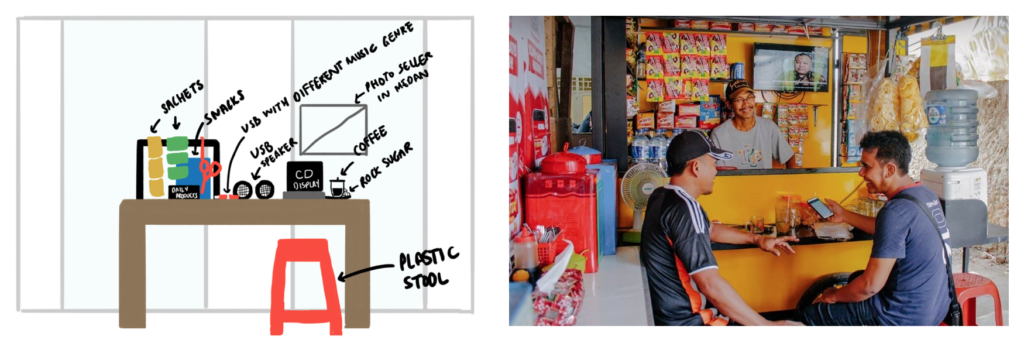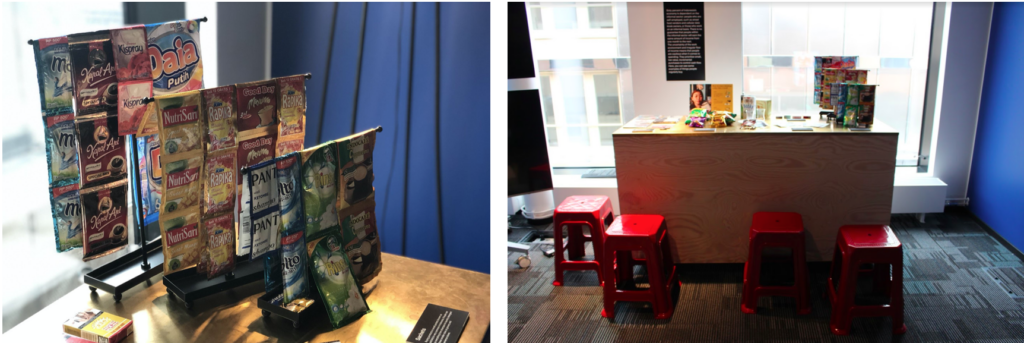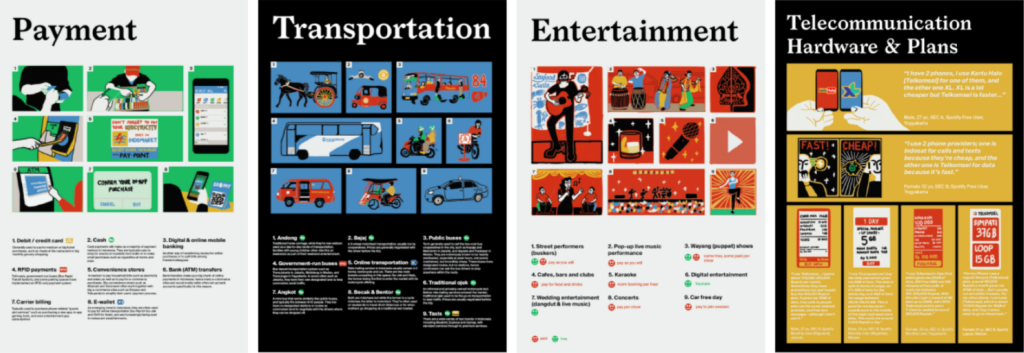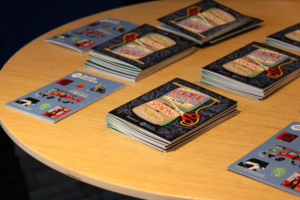Through the art of exhibition, curators immerse people in new worlds and new points of view, whether by transporting visitors to 18th century India or through challenging art history’s colonial gaze. The goal of an exhibition is a shift in perspective, to move people to think differently about something than they did before.
Researchers do something similar: our first task is to learn something new, but the ultimate goal is to share what we learn in a way that shifts the perspectives of our colleagues, organizations or clients. In this article, we show how we applied curation techniques for a project we worked on together at Spotify. The project focused on understanding people in Indonesia who bought Spotify Premium, and the exhibition served as our main deliverable. The exhibition jump-started a new way of thinking about Spotify users because it enabled our colleagues to experience a different understanding of value and music streaming in the country.
Why an Exhibition, not a Report?
A streaming service as a product tends to imply that for a monthly fee a person gets ‘unlimited access to an unlimited catalogue’ of content. A subscription ensures that the content is always there, on demand—this is core to the experience. Companies that offer streaming services assume that this consistency is a primary source of value and loyalty.
Yet, we saw a different behaviour emerging in Indonesia. A certain group of people were buying Spotify Premium by the day, or by the week. This seemed counterintuitive to the very foundation of our subscription service, and we had to dig deeper. Our research questions focused on understanding lifestyles and habits of this particular customer group. Who was it that streamed music in this way? What cultural or economic forces undergirded their purchasing behaviour? How might these influence the way a person listens to, streams and buys music?
We embarked on an investigation to better understand the conceptions of value in the parts of Indonesia where we saw this behaviour most. Even as we began to plan our research in early 2019, we sensed that it would need to be communicated in a more visual way than the majority of projects (even in the foundational phase) because of the challenge of the research question and content. Our objective was not to go out and report on a prototype so much as to try to understand conceptually the reasons why people consumed (and paid) for music in ways that were very different than in places we’d more typically designed for, such as the United States.
Our fieldwork—a combination of cultural immersions and in-home interviews—affirmed our initial inklings about the importance of a visual and experiential output. We discovered that the underpinnings of this purchasing behaviour were mostly contextual in nature—economic and cultural forces unique to Indonesia. To fully appreciate this ‘sachet mindset’, and to trigger the paradigm shift we needed to make across Spotify to engage with it, we needed to give our business and product teams a way to experience this context. We realised that this would be very difficult to achieve through a standard research report.
Our Exhibition: “Bite-Size Life: Short-Term Spending in Indonesia”
We wanted to create an exhibition that would momentarily detach Spotify staff in Stockholm from their own realities, placing them into a multisensory context of Jakarta. The goal was for them to come out of the exhibition with a contextualised understanding of what ‘value’ meant through the lens of Indonesian daily and weekly subscribers. So we designed our exhibit as a three-step experience: detach, immerse and internalise.
Early sketches of the exhibition
Detach
Since the exhibition was located in Spotify headquarters, it was important for visitors to detach from the work contexts they were inevitably immersed in when they approached the space. As a prelude and exhibition launch event, we invited people to an auditorium for a short presentation of our learnings, before opening the exhibition space. Before entering the exhibit, we provided typical Indonesian snacks with distinctive local flavours and spices, a tasty first impression that also served the underlying purpose of priming participants to experience something new.
Immerse
Within the exhibit itself, visitors first experienced a short film with sights and sounds of Jakarta, along with commentary from locals about life in the city. Many of the underlying reasons behind Indonesians’ ‘sachet mindset’ has to do with their living environment. For most Spotify staff in Stockholm, life in urban Indonesia appears chaotic, uncertain and unstructured. An outsider struggles to find logic. So offering visitors a more ethnographic experience of the ways local people make sense of their world—in their own terms—is essential before addressing business or product-related questions that were formulated in Spotify’s own Stockholm-based business terms.
Next, we invited visitors to play around with a display of objects typical of Indonesians’ single-serve consumption habits across a number of categories, from coffee to snacks to detergents. These were mostly objects typically found in a warung (neighbourhood shop).
Several posters further illustrated manifestations of sachet-type consumption in payments, transportation, entertainment and telecommunications. Our colleagues could see that this kind of consumption is socially pervasive in Indonesia, across many essential aspects of people’s daily lives. Something that would otherwise seem strange and exceptional at our desks in Stockholm, instead feels normal and logical within our exhibit.
Internalise
At the end of the journey, we invited visitors to share their reflections on what these insights could mean for Spotify’s Indonesian business and beyond on an exhibition panel. We used their ideas to inform the next steps for the project. And to ensure what they had learned continues to live beyond the exhibition, our team created a short booklet showing the artefacts and displays, along with stickers to serve as everyday visual reminders.
Can a Temporary Exhibition Have Lasting Impact?
Because ethnographic research is sensory and immersive, it is difficult to translate into a report and presentation in the office context. But the impact of our work depends on successful translation. So we used the format of the exhibition to turn the office into the fieldwork context—or at least enough to accomplish the essential journey of detach, immerse, internalise. We lifted our colleagues out of their day-to-day working lives and invited them to step into the world of urban Indonesia.
Because our exhibition was experienced in person (May 2019), it was not possible for those from other offices to join and experience it. This was a limitation to sharing our insights and immersing our colleagues. This limitation is even more striking today, with many offices shut for the foreseeable future. Considering this, building an online component, perhaps a website or a digital tour, can make exhibitions more accessible, thus increasing impact. The three-step process is amenable to the kinds of visual and digital storytelling that have strong traditions in ethnography, film and other fields.
Our research and exhibition strongly informed the way that Spotify as a whole organization considers our potential users in Indonesia, and we are reconsidering our propositions. Using the visual medium of the exhibition, we demonstrated the significance of meeting our users where they are in their spending habits and lifestyles.
Related Articles
Ethnography and Music: Disseminating Ethnographic Research inside Organizations, Luis Arnal & Roberto Holguin
Media, Mediation and the Curatorial Value of Professional Anthropologists, Michael Powell
Enriching Ethnography in Marginalized Communities with Surrealist Techniques, Andrea Judice et al








0 Comments